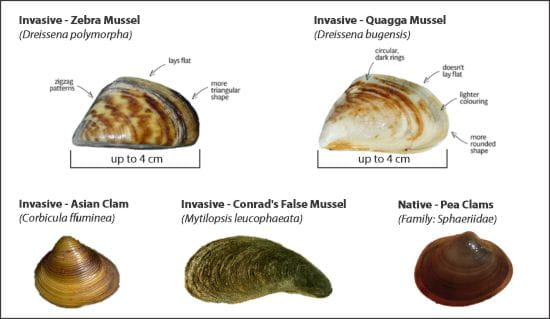If you find evidence of invasive zebra or quagga mussels, or other prohibited aquatic invasive species, please call the 24-hour TIPP line at 1-800-667-7561 or report online.
Aquatic invasive species are fish, invertebrates and plants that have an impact on the environment, economy and/or society when they are introduced to an area where they are not native. Aquatic invasive species possess certain traits that allow them to successfully invade environments, which often results in significant socio-economic and environmental impacts.
Some common traits of aquatic invasive species include:
- the ability to grow quickly and reproduce in large numbers;
- survive in a broad range of environmental conditions; and
- lack natural predators or avoid predation.
Native species have adapted to co-exist and survive in a balance of competition for food and resources. When an invasive species is introduced, their invasive traits disrupt ecological balance and allow them to outcompete native species, change water quality and habitat, or spread diseases.
Negative impacts to society and the economy include:
- reduced recreational angling success;
- reduction in areas suitable for recreation due to excessive growth of invasive weeds; and
- damage to infrastructure and equipment from the establishment of invasive mussels.
Impacts to native fish from aquatic invasive species can cause impacts to recreational angling. Nuisance aquatic weeds can grow and take over beaches and swimming areas. Invasive mussels can cause damage by plugging boat motors and infrastructure. Controlling and managing aquatic invasive species is costly, with projections in the tens of millions of dollars annually in neighbouring jurisdictions for management of zebra mussels alone.
Aquatic invasive species are often spread to new areas by attaching to watercraft, trailers, and equipment that is used in an infected waterbody and moved and used in a new waterbody prior to being properly cleaned, drained and dried. It is important to understand how your actions may inadvertently spread aquatic invasive species and to be familiar with species of concern and how to identify them in order to help report potential new invasions. Learn more about aquatic invasive species of concern and how to identify them below.
Invasive species profiles
Zebra and Quagga Mussels
Zebra and quagga mussels are highly invasive and have not yet been detected in Saskatchewan waters. However, the risk remains high as these organisms have spread to over 34 U.S. states and have invaded Ontario, Manitoba, and Quebec in Canada. Zebra mussels are native to the Black Sea region, while quagga mussels are native to Ukraine. Zebra and quagga mussels were introduced to the Great Lakes area in the 1980's by ballast water that was discharged by cargo ships and subsequently spread through to other waters through the movement of watercraft and equipment.
Zebra and quagga mussels are small bivalves (two shells) that are triangular in shape, and can have light and dark banding, giving the “zebra” appearance. Not all zebra and quagga mussels will have this banding pattern, therefore another way to identify an invasive mussel is by their byssal threads. These threads act like cement, allowing zebra and quagga mussels to attach onto hard surfaces. In Saskatchewan, native “pea clams” are similar in size to invasive zebra and quagga mussels and may have circular rings on their shells. However, native pea clam shells are much rounder and have a small umbo (beak) in the middle of the shell.
Zebra and quagga mussels are prolific breeders and can reproduce in massive numbers. One mature female mussel can produce up to a million eggs each year. The eggs hatch into free swimming microscopic larvae called veligers and are unable to be seen with the naked eye. Veligers can be transported in standing water in boats and gear and float in the water column of lakes and rivers. In moist conditions, such as live wells or in wet storage compartments, adult mussels can survive for up to 30 days.
Zebra and quagga mussels are filter feeders and filter microscopic food such as zooplankton and desirable algae from the water column. In large numbers, zebra and quagga mussels will filter food from the water column and reduce the ability of native species to feed. While it is common for zebra and quagga mussels to partially clear water by filtering the lakes they invade, this increase in water clarity can have severe impacts. Many sport fish, such as walleye, spend majority of their life in the dark waters at the bottom of lakes, and increases in water clarity allows light to penetrate deeper into the water column, forcing these species to find other, less suitable habitat. This water clarity also allows sunlight to reach increased depths of water and can create nuisance blooms of harmful blue-green algae or excess growths of aquatic weeds, which can clog up marinas and make swimming areas less enjoyable.

Zebra and quagga mussel sightings map

